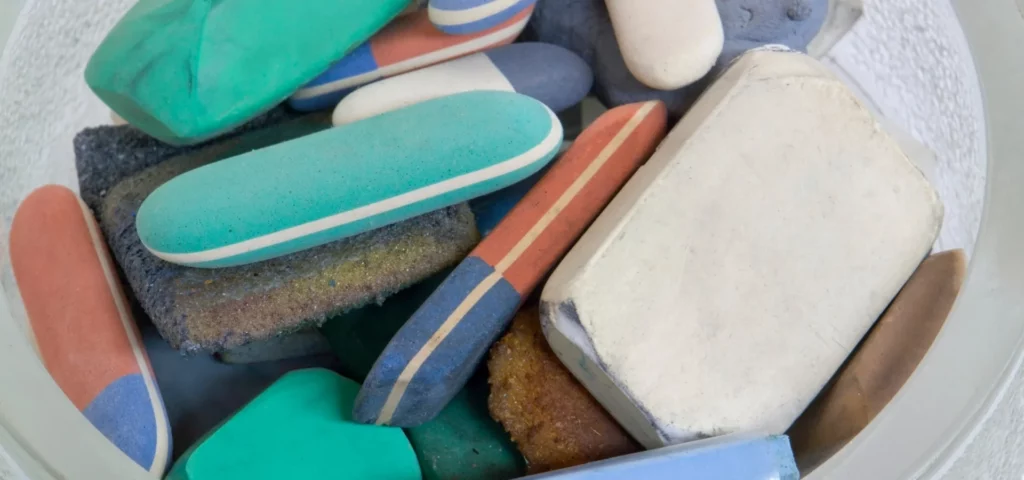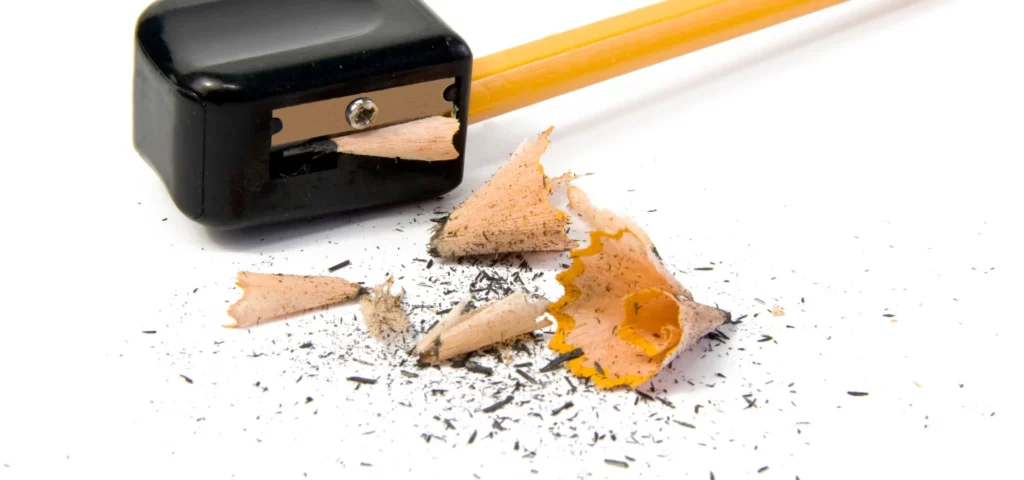Choosing the Right Erasers
Selecting the right eraser is crucial for any creative artist looking to achieve perfect drawings. This section dives into two popular types of erasers: kneaded erasers and polymer erasers.

Kneaded Erasers
Kneaded erasers, particularly General’s brand, can be a lifesaver for any artist. They are highly effective for erasing and manipulating graphite in pencil drawings. These erasers are quite versatile; you can gently tap, roll, and create subtle details and textures by pinching them into points (Toad Hollow Studio). If you’ve ever felt like your drawing is a bit too on point, these erasers can be your best friends. They’re like the yoga masters of the erasing world—flexible and calm under pressure.
| Feature | Kneaded Erasers |
|---|---|
| Use | Gently erasing and manipulating graphite |
| Texture | Soft, pliable |
| Best For | Subtle details, gentle corrections |
| Brand | General’s |
Polymer Erasers
Polymer erasers, such as Pentel’s Hi-Polymer Erasers, are known for their precision and efficiency. They are particularly useful for removing graphite without causing damage to the paper, making them ideal for dark areas in a drawing (Toad Hollow Studio). Think of these erasers like knights in shiny armour—they charge in and rescue the drawing without a scratch!
| Feature | Polymer Erasers |
|---|---|
| Use | Removing graphite cleanly |
| Texture | Firm, smooth |
| Best For | Dark areas, precise corrections |
| Brand | Pentel Hi-Polymer |
Choosing the best erasers for drawing can elevate your artistic process. Whether you prefer the malleability of kneaded erasers or the precision of polymer erasers, understanding their unique applications will help you bring your creative vision to life.
Now go forth, armed with the knowledge to erase like a pro and transform your artwork with confidence and flair. And if you’re looking to dive deeper into specialised tools, check out the next section on Exploring Specialized Erasers.
Exploring Specialized Erasers
When it comes to finding the best erasers for drawing, specialised tools can make a world of difference. Let’s dive into two fantastic options: The Kemper Wipe Out Tool and the Tombow Mono Zero.
Kemper Wipe Out Tool
The Kemper Wipe Out Tool, though originally designed for shaping clay, has found its way into the hearts of artists as a superb eraser. This dual-ended tool features rubber tips that are perfect for detailed work. Gently stroking and dabbing with the rubber tips allows for precision erasing without damaging your prized artwork (Toad Hollow Studio).
| Feature | Details |
|---|---|
| Usage | Shaping Clay, Detail Erasing |
| Material | Rubber Tips |
| Cleaning Method | Clean on Kneaded Eraser |
| Durability | Lasting Points |
Ever fancied a tool that converts a slip-up into a masterpiece? Look no further. The Kemper Wipe Out Tool is a magician in the art world, turning your pencil smudges into barely-there shadows. It’s an absolute must-have for those intricate spots where your hand seems to have a mind of its own.
Tombow Mono Zero
The Tombow Mono Zero isn’t just an eraser; it’s an eraser with an attitude. This tiny, round, stiff eraser can get into the tightest spots without leaving a mark on your paper. It’s refillable — which means it lasts longer than your obsession with finding the perfect tool! And, if you need even more precision, you can trim it into a thin wedge for some seriously detailed erasing work (Toad Hollow Studio).
| Feature | Details |
|---|---|
| Diameter | Small Round |
| Usability | Tight Areas, Detail Erasing |
| Refillability | Yes |
| Customization | Can be trimmed |
The Tombow Mono Zero is the James Bond of erasers. Imagine having the stealthy skills to sneak into any tiny corner and fix intimidating pencil marks without breaking a sweat. Perfect for detailed drawings where every line matters.
Delving into specialty tools like the Kemper Wipe Out Tool or the Tombow Mono Zero can elevate the quality of your artwork. There’s no mistake too glaring for these incredible erasers to fix. They’re essential assets for anyone serious about drawing, providing unparalleled precision and durability.
Sharpeners for Precision
When it comes to adding those final, immaculate touches to your masterpiece, precision is key. And what better way to achieve precision than with the right tools?

Pencil Sharpener Types
For the aspiring Van Gogh or Picasso, the art of sharpening pencils becomes almost as essential as the art itself. The right sharpener can make all the difference. There are three major schools of thought when it comes to pencil sharpeners: hand-held, crank (also known as helical), and electric.
- Hand-held Sharpeners: Nimble and portable. Perfect for the artist who values control. Hand-held sharpeners are great for on-the-go touch-ups and come in various sizes to accommodate the myriad of pencil types an artist might use. The Prismacolor Sharpener, is a popular choice thanks to its reliability.
- Manual Crank Sharpeners (Helical): Known for their precision. These sharpeners, like the Derwent Super Point Mini Manual Sharpener, feature a durable helical blade and a self-feeding mechanism that stops at the desired point. This sharpener also comes with a transparent sliding tray reservoir, perfect for those who like to admire their sharpening debris.
- Electric Sharpeners: For the modern artist who values efficiency. Ideal for high volumes of sharpening, these gizmos are available in both mains and battery-powered variants. Artists who use pencils daily, and who prefer a hands-free experience, swear by electric sharpeners.
Manual vs Electric Sharpeners
Ah, the age-old debate: manual crank vs electric sharpeners. Each has its own virtues and quirks, and the choice largely depends on one’s sharpening philosophy.
Manual Crank Sharpeners
Manual crank sharpeners, also known as helical sharpeners, provide a mechanical pleasure akin to winding up a timepiece. They offer unparalleled control over the length and angle of the pencil point. One specific advantage involves adjusting the length of the point on the pencil, perfect for nuanced, detailed work. Unlike their single-blade cousins, helical sharpeners feature a cylindrical barrel with a spiral pattern that grinds the pencil to a pristine point.
Electric Sharpeners
Effortless and consistent, electric sharpeners are the workhorses of the art world. Whether battery-powered for portability or mains operated for endless power, these sharpeners cater to those who value efficiency. Artists who detest manual labour or require frequent sharpening sessions find solace in these devices. They come equipped with safety features to prevent over-sharpening and can handle a variety of pencil types.
Whether you lean towards the meticulousness of manual sharpening or the zippy convenience of electric, remember, the journey to the perfect point is just as artful as the creation that follows.
Choosing the Right Sharpener
Selecting the right sharpener is a crucial decision for any artist. Whether your style leans towards detailed line work or broad strokes of colour, you need a sharpener that meets your unique artistic needs. Let’s explore the key factors to consider: helical vs single blade and size vs portability.
Helical vs Single Blade
When it comes to sharpening, not all blades are created equal. Artists may find themselves in the midst of the age-old debate: helical or single blade?
Helical Sharpeners
Helical sharpeners, also known as manual crank sharpeners, are the bodybuilding champions of the sharpening world. They feature a cylindrical barrel with a spiral pattern that glides around the pencil, grinding it to a fine, precise point. This mechanism provides more control over the sharpening process, allowing artists to adjust the point length of their pencils. And if you’re someone who spends hours sharpening away, these will handle high volumes like a pro.
On the flip side, helical sharpeners can be bulky and might not fit comfortably in a cosy art studio. But if you don’t mind a bit of heft, their durability and precision make them a worthy investment.
Single Blade Sharpeners
Single blade sharpeners are the minimalists of the sharpening world. They consist of a single blade positioned at an angle to the pencil. These sharpeners are typically lightweight, compact, and easy to carry around. They’re perfect for artists who need to travel light or work on the go.
However, single blade sharpeners may not provide the same level of precision as their helical counterparts. They can also wear out faster, especially if used on a variety of pencils such as coloured, graphite, and charcoal. Regular maintenance is needed to keep the blades sharp and effective.
Size and Portability Factors
When selecting a sharpener, size and portability are important considerations. Do you need a sharpener that can be easily toted around in your art bag, or one that stays anchored to your desk?
Portability
For artists who are constantly on the move, a portable sharpener is a must. Compact single blade sharpeners shine in this arena. They slip easily into a pocket or pencil case, making them perfect for quick, on-the-go touch-ups. (Art Supplies UK).
Size
If you primarily work in a fixed space, size might not be as critical. This is where helical sharpeners take the stage. Despite their bulk, these sharpeners offer superior durability and adjustable sharpening options, making them ideal for a permanent art station.
The right sharpener enhances your creative workflow and prolongs the life of your precious drawing tools. Beyond choosing between helical and single blade, consider whether portability outweighs the need for precision in your artistic endeavours. Happy sharpening!

